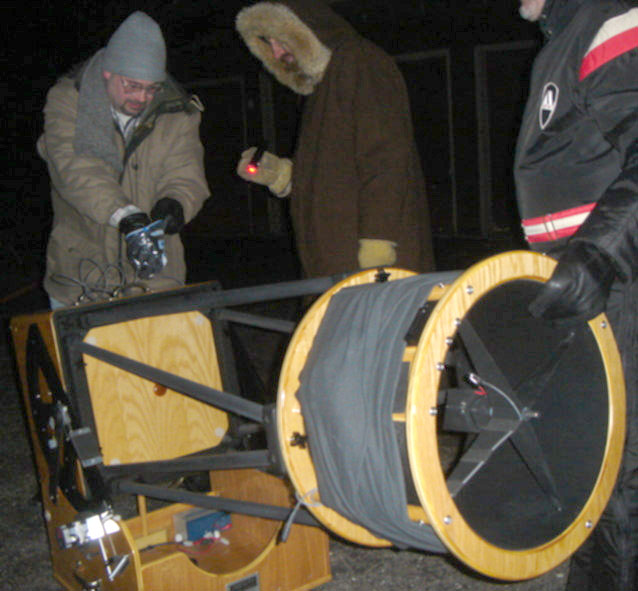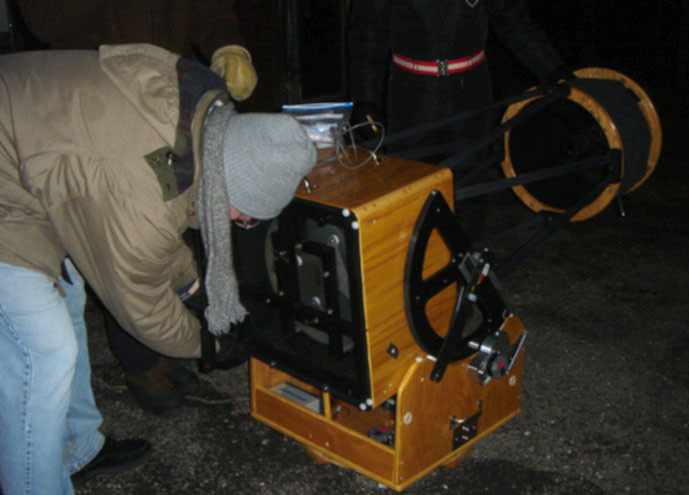

Everyone knows that feeling—the anxious anticipation experienced between the time you purchase or build new optics, and the time you actually get to use it for the first time. For me, it started with a mild case of aperture fever about a year ago....
I think there is no such thing as a mild case of this disease. It creeps up on you when friends, family, and even co-workers show up on clear nights, and let you look at the sky with their newest toys. I just knew I had to upgrade from my 90mm Maksutov-Cassegrain telescope. I started dreaming about those big ‘scopes some of you possess, and started shopping around. Originally, I thought about a 200mm (8 inch) telescope. But then the fever grew worse, and I knew I had to have a 250mm (10 inch) ‘scope. As the days went by, I started dreaming even bigger. Yep, in my minds eye, I saw myself toting around a 460mm (18 inch) scope before I finally said to myself: How am I going to move such a monster in my little car? I also started saving my pennies, for I realized this was going to be a major purchase. I realized that there would be a second purchase in my immediate future—A new car of course.
About 6 months ago, I decided that I was going to buy a StarMaster telescope. Many factors went into the decision: I considered portability, ease and time needed for setup and teardown, and ease of use. I also liked the fact that you could have digital setting circles and computer-controlled go-to and track installed. The ability to switch back and forth between computer-controlled and traditional hand-guided star-hopping modes with-out resetting the computer was a big plus. The fact that another club member owns a large StarMaster did not hurt, since I could see what the telescope looked like, and how it worked firsthand. I also knew I would have many questions when the telescope arrived, and there is nothing better then knowing that help is only a soft shout away as you fumble around in the dark. My biggest concern was whether or not my current (1.25 inch) eyepieces would work in the new scope, and if my web-cam could be used. I’ll say more on this a little later.

In the end, the really tough decision was the aperture. I simply could not decide between the 16 inch versus the 14.5 inch telescope. I asked many of you what you considered better, and why. Your answers included factors such as weight, cool-down time, differences in light-grasp, etc. But one thing was not mentioned that eventually swayed me: the height of the eyepiece when the telescope is pointed straight up. I do not want to climb a step-ladder to observe. I’m far too clumsy, I am afraid I would fall down one night, and damage the telescope (never mind damage to myself). The eyepiece on the 16-inch model is too high, but 14.5 inch is “just right.” I don’t have to bend over, nor stand tippy-toe to see. Hopefully, I won’t shrink too much as I get older.
On Saturday, Dec 10, I sent my first e-mail to StarMaster with a couple of minor questions. I figured that I would see a response on the following Monday, but I was in no hurry. But in fact Rick Singmaster (proprietor of StarMaster) called me at home that very night (a Saturday!) at about 7:30pm local. Even though his shop is in Kansas, and thus a couple of hours behind us, this is still pretty late. Rick answered all my questions and concerns very quickly. We spent about over hour on the phone, discussing things I had not considered (such as collimation). Truly, Rick enjoys talking about astronomy; I was impressed by this personal touch.

The following Monday (Dec 13), I placed an order for a 14.5 inch telescope, with almost every option. I was pleasantly surprised when they indicated it would take 60 to 90 days for the telescope to be built. I expected a much longer wait, but Rick indicated that the last set of mirrors he had ordered (but had not yet arrived) included a 14.5 that had not been sold yet. I was to get the last one in the set; the next person ordering a telescope will wait about twice as long.
In the universe I live in, I generally expect anything I order to take much longer than expected. Still, I figured I would have the new toy sometime in the spring, just as the winter clouds became a memory. So imagine my very great surprise when an e-mail arrived on January 12, indicating that my ‘scope had been completed and tested! Only one month after being ordered! I was told that the telescope would be ready to ship in about a week (they were waiting for a new digital-setting-circles computer). On Monday, January 30, I was notified that the telescope had been shipped, and should arrive in about 4 days. Exactly 4 days later, the telescope arrived, on time.
The scope arrived in 7 big boxes. The pieces were so well packed that it took me 3 hours to open every box, remove all the bubble-wrap, and take inventory. StarMaster takes no chances; everything arrived in pristine condition. Do you know that “new car” smell? I was floating about in my living room on the “new telescope” smell (which actually smells a lot like curing lacquer). I spent the rest of the day putting the scope together, and making sure the electronics worked properly (everything was fine).
Still, when things start going too well, the universe will throw something at you to counter-balance the affect. For astronomers, this means clouds. Lots of clouds. Endless night after cloudy night. Two days after the telescope arrived, Mother Nature provided us with 4 inches of snow. I had to rearrange my family room to create space for the scope. I used the time to assemble, collimate, disassemble, reassemble, and re-collimate. After all, practice makes perfect, and I did not want to waste time on the next clear night. Every night I looked outside wishing it would clear up. On February 7th, a brief hole opened up in the late afternoon, so I rushed home to gather “first light.”
The opening in the sky lasted only a couple of hours, yet this was enough time for me to set the scope up, rush through collimation, and point it at the moon. My neighbors noticed right away, and came by to talk, and to see what I was up to. All I wanted to do was to observe, but one must be polite. Nonetheless, the view of the moon was truly outstanding. I could easily see features in the twilight of the setting sun that I could never have seen in my little 90mm. But I could also see that the image was not equally sharp in the entire field of view. So I took a quick look at Mars. And found that poor Mars looked more like a comet than a planet. I decided to check collimation, and yes, I had done a poor job. Unfortunately, the clouds rolled back at this point, so I had to pack things up.
Those of you who spend hour after hour under an open sky searching for faint fuzzies know that Mother Nature is often very whimsical. She is sometimes a harsh mistress. So it was on Valentines Day that the next usable opening occurred in the sky. How cruel, to choose between one love and my better half on this day. My better half won, of course. But I am fortunate that she is an understanding woman. Lisa indicated that I could observe from the driveway until she came home from work. On this particular evening, it turned out she was kept at work, so I had plenty of observing time.
I took my time collimating the scope. The first target: Rigel. At very low magnification, I could see that my effort paid off—I could very easily see its companion (a magnitude 6.7 star about 9 arc-seconds from the brilliant 0.1 magnitude primary) and there were no funny streaks. Next, I pointed the scope at M42. It was still too bright to see the nebula, but my goal was to look at the trapezium. Again, a perfect image. Although I was using low power (about 73X), I could easily see all six stars. Those stars were perfect pinpoints.
I spent the next 90 minutes hunting the sky, mostly looking at various open clusters. I did take a moment to return to Mars, and found the red planet to look as good as could be hoped for. Finally, I pointed the telescope at my favorite object, Saturn. All I can say is wow. You will have to wait for the next Open House to see what I mean.